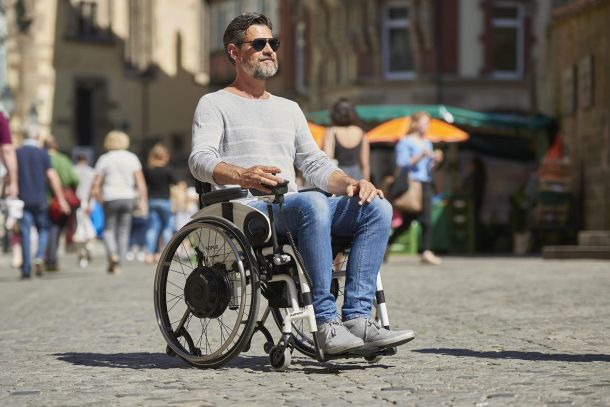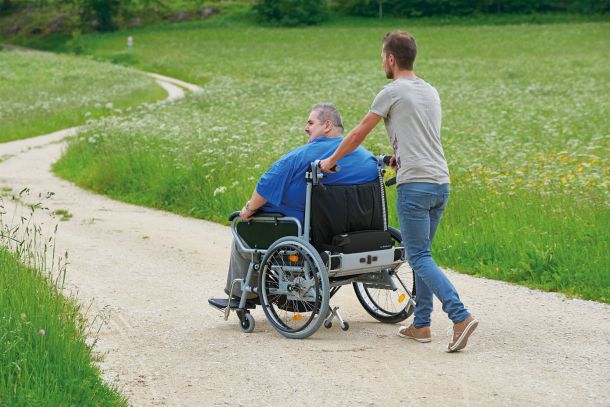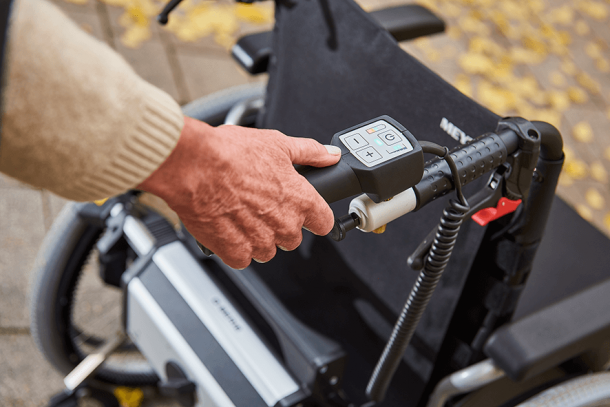What is an electric auxiliary drive for self-propelled vehicles?
Summary: how to choose the right wheelchair
The following aspects are important when purchasing a wheelchair:
- Type of wheelchair: Based on mobility impairment and place of use.
- Seating comfort and ergonomics: Adjustability, upholstery and positioning.
- Size and weight: Lightweight, foldable models for easy transportation.
- Safety features: Brakes, reflective elements and standards.
- Service and spare parts: Advice from specialist dealers and ensuring availability.
An electric add-on drive for wheelchairs is a powerful drive that can significantly improve the mobility of wheelchair users. It is attached to the wheelchair and allows the wheelchair user to control it themselves.
An auxiliary drive makes it easier to move forward, especially on uneven or steep terrain, and also extends the wheelchair user's range of action. It can either remain permanently on the wheelchair or be removed as required, depending on the user's individual needs. The control unit is simple and intuitive to operate, making it easy to control the wheelchair drive. With an electric add-on drive for wheelchairs, you can enjoy more independence and freedom in your everyday life.
Advantages of an auxiliary drive for self-propelled vehicles
Summary: how to choose the right wheelchair
The following aspects are important when purchasing a wheelchair:
- Type of wheelchair: Based on mobility impairment and place of use.
- Seating comfort and ergonomics: Adjustability, upholstery and positioning.
- Size and weight: Lightweight, foldable models for easy transportation.
- Safety features: Brakes, reflective elements and standards.
- Service and spare parts: Advice from specialist dealers and ensuring availability.
An electric auxiliary drive for self-propelled vehicles offers many advantages. It enables greater independence and mobility as it offers a larger range of movement. It also makes it easy to negotiate inclines and declines, which can often be difficult without an auxiliary drive. Even longer distances can be covered without effort.
A lightweight add-on drive is easier to transport than a fully-fledged power wheelchair and is also airplane-compatible. This makes traveling with a wheelchair easier and more comfortable.
Different types of electric auxiliary drives
Summary: how to choose the right wheelchair
The following aspects are important when purchasing a wheelchair:
- Type of wheelchair: Based on mobility impairment and place of use.
- Seating comfort and ergonomics: Adjustability, upholstery and positioning.
- Size and weight: Lightweight, foldable models for easy transportation.
- Safety features: Brakes, reflective elements and standards.
- Service and spare parts: Advice from specialist dealers and ensuring availability.
There are various types of electric add-on drives that can support a wide range of applications. One example is the wheel hub drive, which is fitted directly in the hub of the wheelchair wheel and drives it directly. Wheel hub drives are particularly easy to handle as they do not have any quick-release axles and are therefore particularly easy to attach or remove.
The battery is usually located in a battery bag underneath the wheelchair or is integrated into the drive wheels. One advantage of a removable battery is that it is easier to charge and store. For example, the wheelchair with drive can remain in the hallway after a trip in the rain, while the battery can be taken into the home separately.
Another option is an electric drive that is attached to the wheelchair via a bracket underneath the backrest. This bracket holds the drive securely and ensures that it can be attached and detached quickly. The drive is connected to the wheelchair wheels via drive shafts. The wheelchair wheels are fitted with sprockets in advance, which the drive shafts use to drive the wheels. The direct power transmission between the motor and wheels is crucial for the efficiency of the drive. This makes the drive robust and low-maintenance. Another advantage of this drive concept is that the additional weight of the wheelchair wheels is virtually eliminated.
You can choose between different control unit attachments such as a regular joystick, a softball, a tetra fork or other variants. This allows you to retain control of your auxiliary drive and make optimum use of it.

How do I apply for an electric auxiliary drive?
Summary: how to choose the right wheelchair
The following aspects are important when purchasing a wheelchair:
- Type of wheelchair: Based on mobility impairment and place of use.
- Seating comfort and ergonomics: Adjustability, upholstery and positioning.
- Size and weight: Lightweight, foldable models for easy transportation.
- Safety features: Brakes, reflective elements and standards.
- Service and spare parts: Advice from specialist dealers and ensuring availability.
The first step before applying for an aid is a personal and individual consultation. Many manufacturers also offer an on-site service and will visit you at home. You should try out the various drive models in your familiar surroundings and select the model that best meets your requirements and needs.
To apply for the selected add-on drive, you will then need to make an appointment with your doctor. Your doctor will check whether such an aid is necessary and, if necessary, issue you with a prescription. This prescription should always include the product name of the product that you have selected and already tested extensively.
You can then use this prescription to contact a medical supply store in your area. They will contact the manufacturer of the electric drive and also send a cost estimate to your health insurance company. Most electric drives have an official medical aid number. The cost of the aid is therefore usually covered by your health insurance company and once it has been approved, the desired aid will be ordered and delivered to you as quickly as possible.
You can also find more information here:
Maintenance and care of an electric auxiliary drive
Summary: how to choose the right wheelchair
The following aspects are important when purchasing a wheelchair:
- Type of wheelchair: Based on mobility impairment and place of use.
- Seating comfort and ergonomics: Adjustability, upholstery and positioning.
- Size and weight: Lightweight, foldable models for easy transportation.
- Safety features: Brakes, reflective elements and standards.
- Service and spare parts: Advice from specialist dealers and ensuring availability.
The maintenance and care of an electric auxiliary drive for self-propelled vehicles is important to ensure optimum performance and longevity. It is advisable to follow the operating instructions and manufacturer's instructions to ensure that you use and care for the drive correctly. Check the wearing parts regularly to ensure they are replaced in good time.
If you have technical problems or questions about maintenance, you should contact your medical supply store or the manufacturer. Also, do not forget to charge the battery regularly to ensure constant performance.
Frequently asked questions (FAQs)
Will my health insurance cover the costs of an add-on drive?
In most cases yes, but this depends very much on the individual situation of the applicant and the specific guidelines of the health insurance company.
Is a wheelchair drive classified as a medical device?
Yes, a wheelchair drive is indeed a medical device, as it is used to promote and maintain the health and well-being of individuals.
Is my wheelchair suitable for a power-assisted add-on drive?
Generally speaking, add-on drives can be fitted to most standard manual wheelchair models. Your medical supply retailer will check with the manufacturer whether your wheelchair model is compatible.
What happens if my needs change over time?
Most add-on drives are very flexible and adaptable. Often only a few parts need to be replaced if, for example, a wheelchair needs to be changed. Some drives can even be retrofitted as a pushing and braking aid by ordering additional handles as accessories. If necessary, contact your medical supply store or the manufacturer.
Is an add-on drive also suitable for children?
Yes, many add-on drives are also suitable for children. Some drives can be attached to the wheelchair from a seat width of 28 cm and grow with the child over the years thanks to an adjustable width adjustment.
How do I travel by air with an add-on drive?
There are a few points to bear in mind when traveling by plane. Clarify the details with your airline in good time to ensure a smooth flight. In principle, wheelchairs with an auxiliary drive can be transported without any problems, but there are restrictions depending on the type of battery.
Your medical supply store or the manufacturer will provide you with transportation certificates such as a declaration of no objection. You should provide these to your airline.
Also ensure that all components are packed appropriately to protect them from damage in the hold. Removable lithium-ion batteries must be transported in hand luggage. For this purpose, some batteries can be switched to a so-called "flight mode" to render them inoperable.
For more information, contact your airline or the manufacturer of your add-on drive.







